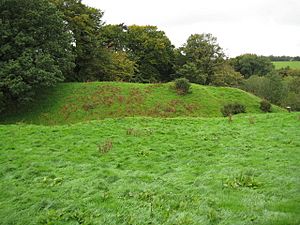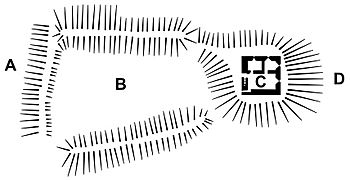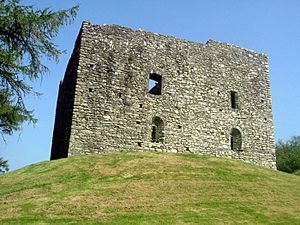Lydford Castle facts for kids
Quick facts for kids Lydford Castle |
|
|---|---|
| Lydford, Devon | |

Lydford Castle's tower, seen from the north-west
|
|
| Coordinates | 50°38′34″N 4°06′41″W / 50.6428°N 4.1115°W |
| Site information | |
| Controlled by | English Heritage |
Lydford Castle is a medieval castle in the town of Lydford, Devon, England. It actually started as two different castles over time. The first one, sometimes called the Norman fort, was a small earthwork castle built around 1068. It was placed inside an old Anglo-Saxon fortified town called a burh. This first castle helped the Normans control Devon after a big rebellion. It was left empty by the mid-1100s.
The second Lydford Castle was built in 1195. This was because there were many problems with law and order across England. This new castle had a stone tower and a surrounding area called a bailey. It quickly became a prison and a court. It was used to enforce laws in the Forest of Dartmoor and for the tin mining areas of Devon.
The tower was rebuilt in the mid-1200s, probably by Richard, the Earl of Cornwall. It was made to look like an older type of castle called a motte and bailey castle. This design showed power and authority. In 1342, the castle became part of the Duchy of Cornwall. It stayed a prison and courtroom for centuries.
The castle was fixed up many times, but also often left to fall apart. So, its condition changed a lot. Lydford Castle was very important for managing tin mining and forest laws until the 1800s. It got a bad name for being unfair, and people complained about "Lydford Law" for a long time. In the early 1800s, Dartmoor Prison was built. Lydford Castle then stopped being the main place for legal matters. By the mid-1800s, it was mostly a ruin.
In 1932, Lydford Castle was given to the state. Today, English Heritage looks after it as a place for visitors. Experts say it's important because it's "the earliest example of a purpose-built gaol" (prison) in England. The remains of the first Norman fort are owned by the National Trust and are also open to the public.
Contents
History of Lydford Castle
The First Castle: 1066–1150
The first castle at Lydford was built after the Norman conquest of England in 1066. In 1068, William the Conqueror came to South-West England. He wanted to stop the Anglo-Saxon rebellions against his rule. William built castles in important towns. He built new castles in Devon, including one in Lydford.
Lydford was then called Hlidan. It was a strong Anglo-Saxon town known as a burh. The castle, now called the "Norman fort," was built in the south-west corner of the burh. This happened soon after 1068. It was a ringwork castle, about 55 by 60 metres in size. The existing town walls helped protect it. Most of the castle's inside was used to store grain. We don't know if this grain was for Norman soldiers or for trade.
This first castle was used for only a short time. It seems to have been left empty by the mid-1100s. The grain stores were destroyed by fire, but we don't know why. Around this time, the town of Lydford itself was also becoming less important.
The Second Castle: 1150–1239
Building the New Castle
In the late 1100s, King Richard I's government tried to help Lydford grow. They wanted to improve trade in the town. But in 1195, there were many law and order problems across England. Because of this, King Richard's government decided to build a new castle in Lydford. It was meant to hold royal prisoners. This new castle was built near the town's church. It was in a more important spot than the old castle.
We are not sure why they chose a new spot for the castle. The new castle cost £74 to build. This money came from the King's income in Devon and Cornwall.
The castle was a stone tower with a surrounding bailey. The bailey was a rectangle, about 55 by 40 metres. It had earth walls and deep ditches on some sides. The old town walls helped protect another side. The south-east side was probably the entrance to the castle.
The tower was a square building, about 16 by 16 metres. It was at least two stories tall. In the 1100s, it sat on flat ground without a mound. The walls were made of slate and granite and were very thick, up to 3.3 metres. They had narrow openings for arrows. The tower had a wall down the middle, dividing each floor into two rooms. The entrance was likely on the first floor. It even had an indoor water supply.
Its Role in Law and Order

Lydford Castle was not mainly built for fighting. But in 1199, when King John became king, he put soldiers there. He also added expensive equipment to stop any trouble. The castle did not have common military features like outside gatehouses. Its design was more about showing authority than stopping an attack. Instead, the castle was built to enforce stannary and forest law in Devon.
Stannary law was a system of rules for the tin mining industry. South-West England, especially Devon, produced a lot of tin in the 1100s. The King controlled the industry. He taxed the tin and collected fines from those who broke the rules. These laws also helped manage problems between miners and other local people. Tin production grew, so the King wanted more control and money. In 1198, William of Wrotham became the Warden of the Stannaries. He was in charge of the mining industry. Stannary courts were set up in Devon. Lydford Castle became the prison for these courts from 1198 onwards.
Forests were special areas of land owned by the King in medieval England. They had their own laws, called forest law. These areas provided money or materials for the King. In 1195, the Forest of Dartmoor covered all of Devon. But in 1204, King John made the royal forest smaller. It became the area we know today as Dartmoor. This smaller forest still had forest laws. Special officials met at Lydford Castle to give out fines and punishments. The castle and forest were probably given to the Sheriff of Devon, William Brewer, in 1216. Later, in 1239, King Henry III gave them to Richard, the Earl of Cornwall. The Forest of Dartmoor became a "chase," but the Earls of Cornwall still held courts at Lydford Castle. They enforced rules similar to the old Forest Laws.
Rebuilding the Castle: 1239–1278
Richard, the King's second son, took control of Lydford Castle in 1239. He was the Earl of Cornwall. Richard was very interested in improving Lydford town. He started a new market and a new fair in the 1260s. Around this time, the main tower at Lydford Castle was pulled down and rebuilt. Richard probably did this, maybe after a big fire. Richard was a rich and powerful person. Rebuilding the castle showed his importance in the area.
The old tower walls were cut down to about 4.3 metres high. The arrow slits on the ground floor were filled in. Then, two more stories were built on top of the old walls. These new parts were better built, with more granite stone. The walls were thinner, about 1.8 metres thick. The new tower was a bit smaller, about 14.6 by 14.3 metres. The first floor was simply designed. It had rooms for prisoners. The second floor was nicer, with a hall and a chamber. This was probably used as the courtroom and living space for the castle keeper.
As part of the work, an earth mound, or motte, was piled up around the base of the tower. This mound was about 5.2 metres high. The castle's original ground floor became an underground cellar. This was probably used as a pit for holding prisoners who were not important. You would reach it by a ladder from the first floor. We don't know why the mound was built. It was probably not for defense. Instead, it was likely meant to look like older motte and bailey castles. This made the castle seem more powerful and important.
Changes and Challenges: 1278–1642
Richard's son, Edmund, became Earl in 1278. He was not very interested in Lydford Castle. He preferred other castles. By the time he died in 1299, the castle was falling apart. It went back to the King. When King Edward II made his friend, Piers Gaveston, the Earl of Cornwall in 1307, Lydford Castle went to him. The castle was fixed up and used as a prison again.
After Edward II lost power in 1327, the castle was looked after by Thomas le Ercedekne for a while. In 1329, the castle was worth a little over £11. Piers Gaveston's wife, Margaret de Clare, rented the castle to Tavistock Abbey. It continued to be a prison.
Edward, the Black Prince became Duke of Cornwall in 1337. He got Lydford Castle when Margaret died in 1342. Big repairs were done over the next three years. The castle was then in good condition, with a strong roof and nice inside. For the next two hundred years, the castle's condition went up and down. Around 1390, the lead from the castle roof was taken to use on other castles. The castle well might have been dug in the 1400s. After 1425, the King rented it to different people.
Lydford stayed the main place for forest administration through the 1300s and 1400s. By the end of the 1300s, the prison had a bad reputation. People said the conditions were very grim. The first poems complaining about "Lydford Law" appeared in 1399. These poems were popular for centuries. In 1510, Richard Strode, a Member of Parliament, was arrested. He was trying to change the Stannary laws. He was put in Lydford Castle. He later said he was kept in an underground room. He was given only bread and water and had heavy chains on his legs. He had to pay the keeper to remove the chains.
After 1485, the Duchy took direct control of the castle again. By 1546, it was in bad shape. Queen Elizabeth I had it repaired. But a report in 1618 said it was too broken to be a prison. More repairs were done in the 1620s and 1630s under King Charles I.
Decline and Ruin: 1642–1900
Lydford Castle was part of the English Civil War that started in 1642. This war was between King Charles I's supporters and Parliament. The Royalist commander, Sir Richard Grenville, used the castle as his main military prison. Parliamentarians said it had a terrible reputation. They claimed prisoners were treated very unfairly. They also said money was taken from innocent people who feared being imprisoned. At the end of the war, Parliament seemed to sell off the Lydford estate. In 1650, their surveyors said the castle was "almost totally ruined." The tower roof was mostly there, but the floors were collapsing. The whole site was only worth about £80.
When King Charles II returned to the throne in 1660, the castle and forest went back to the Duchy. Sir John Granville became the Master Forester of Dartmoor. The Lydford Castle courts continued to manage the Forest. But the broken building was not fixed. In 1704, a report said that the Stannary laws could not be enforced without a working prison.
Work was done between 1716 and 1733 to fix the castle. The main wall inside was rebuilt. The second-floor windows were made bigger. The courtroom had a special chair for the judge. It also had seats for court officials and a public area. The courtroom was also used for village dances and feasts. But in the early 1800s, Sir Thomas Tyrwhitt began building Dartmoor Prison at Princetown. Dartmoor Prison became more important. Courts started to be held there instead of Lydford Castle.
The castle began to decline again. The courtroom became unsafe. By 1833, the remaining court fittings were removed. In the mid-1800s, the Duchy of Cornwall decided it was too expensive to repair the castle. But the castle area was fenced off to stop children from getting hurt playing on the stones. By the 1870s, Lydford town was much less important than it had been. The castle's roofs and floors had either fallen down or been taken away.
Lydford Castle Today: 20th-21st Centuries
The Duchy of Cornwall owned Lydford Castle into the 1900s. In 1912, an architect suggested turning it into a private house, but the Duchy said no. In 1932, the Duchy gave the castle to the Office of Works. Repairs were done in the 1930s and 1950s. Archaeologists also studied the site in the 1960s. Today, English Heritage looks after the castle. It is a place for tourists to visit. Historian Andrew Saunders says the castle is very important. He calls it "the earliest example of a purpose-built gaol" (prison) in England. The remains of the first Norman fort are owned by the National Trust and are also open to the public. Both castle sites are protected by law as ancient monuments.
|







